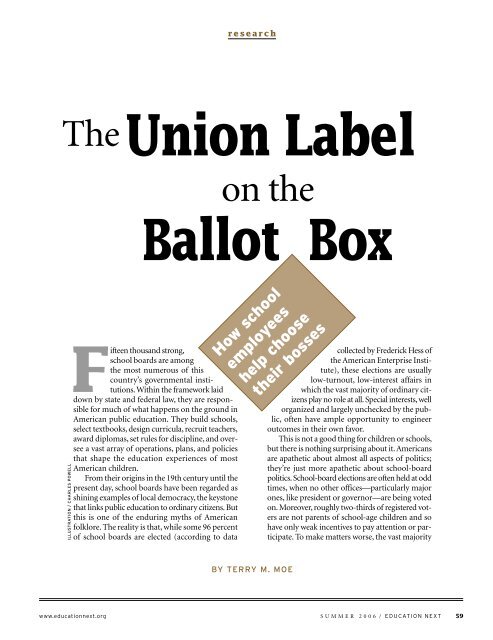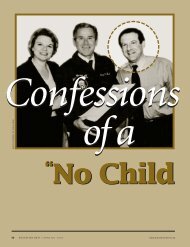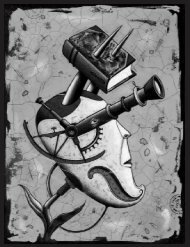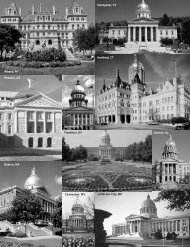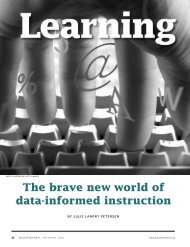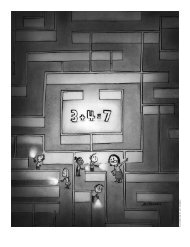The Union Label on the Ballot Box - Education Next
The Union Label on the Ballot Box - Education Next
The Union Label on the Ballot Box - Education Next
Create successful ePaper yourself
Turn your PDF publications into a flip-book with our unique Google optimized e-Paper software.
esearch<br />
<str<strong>on</strong>g>The</str<strong>on</strong>g><br />
<str<strong>on</strong>g>Uni<strong>on</strong></str<strong>on</strong>g> <str<strong>on</strong>g>Label</str<strong>on</strong>g><br />
<strong>on</strong> <strong>the</strong><br />
<strong>Ballot</strong> <strong>Box</strong><br />
Fifteen thousand str<strong>on</strong>g,<br />
school boards are am<strong>on</strong>g<br />
<strong>the</strong> most numerous of this<br />
country’s governmental instituti<strong>on</strong>s.<br />
Within <strong>the</strong> framework laid<br />
down by state and federal law, <strong>the</strong>y are resp<strong>on</strong>sible<br />
for much of what happens <strong>on</strong> <strong>the</strong> ground in<br />
American public educati<strong>on</strong>. <str<strong>on</strong>g>The</str<strong>on</strong>g>y build schools,<br />
select textbooks, design curricula, recruit teachers,<br />
award diplomas, set rules for discipline, and oversee<br />
a vast array of operati<strong>on</strong>s, plans, and policies<br />
that shape <strong>the</strong> educati<strong>on</strong> experiences of most<br />
American children.<br />
From <strong>the</strong>ir origins in <strong>the</strong> 19th century until <strong>the</strong><br />
present day, school boards have been regarded as<br />
shining examples of local democracy, <strong>the</strong> keyst<strong>on</strong>e<br />
that links public educati<strong>on</strong> to ordinary citizens. But<br />
this is <strong>on</strong>e of <strong>the</strong> enduring myths of American<br />
folklore. <str<strong>on</strong>g>The</str<strong>on</strong>g> reality is that, while some 96 percent<br />
of school boards are elected (according to data<br />
ILLUSTRATION / CHARLES POWELL<br />
How school<br />
employees<br />
help choose<br />
<strong>the</strong>ir bosses<br />
collected by Frederick Hess of<br />
<strong>the</strong> American Enterprise Institute),<br />
<strong>the</strong>se electi<strong>on</strong>s are usually<br />
low-turnout, low-interest affairs in<br />
which <strong>the</strong> vast majority of ordinary citizens<br />
play no role at all. Special interests, well<br />
organized and largely unchecked by <strong>the</strong> public,<br />
often have ample opportunity to engineer<br />
outcomes in <strong>the</strong>ir own favor.<br />
This is not a good thing for children or schools,<br />
but <strong>the</strong>re is nothing surprising about it. Americans<br />
are apa<strong>the</strong>tic about almost all aspects of politics;<br />
<strong>the</strong>y’re just more apa<strong>the</strong>tic about school-board<br />
politics. School-board electi<strong>on</strong>s are often held at odd<br />
times, when no o<strong>the</strong>r offices—particularly major<br />
<strong>on</strong>es, like president or governor—are being voted<br />
<strong>on</strong>. Moreover, roughly two-thirds of registered voters<br />
are not parents of school-age children and so<br />
have <strong>on</strong>ly weak incentives to pay attenti<strong>on</strong> or participate.<br />
To make matters worse, <strong>the</strong> vast majority<br />
BY TERRY M. MOE<br />
www.educati<strong>on</strong>next.org SUMMER 2006 / EDUCATION NEXT 59


